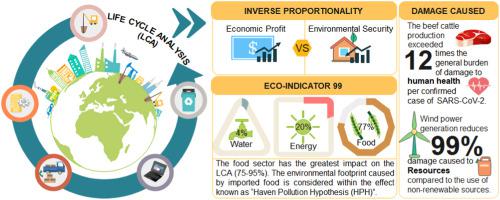Journal of Cleaner Production ( IF 9.7 ) Pub Date : 2023-06-01 , DOI: 10.1016/j.jclepro.2023.137534 Xate Geraldine Sánchez-Zarco , José María Ponce-Ortega

|
Nowadays, ecosystem damages limit sustainable development, which is exacerbated by the scarcity and high demand for resources such as water, energy and food. Therefore, this paper presents a new integrated circular economy approach to optimize the generation, use, and distribution of resources in a given region that takes into account the environmental footprint while considering the net social benefit. Multiple objectives, such as nexus security and environmental damage, are prioritized in terms of three categories: human health, ecosystem quality and resource depletion. The optimization model includes the life cycle analysis for each technology or extraction source with the eco-indicator 99 methodology throughout the supply chain. The determinant variables identified were water availability, renewable energy production and local food production. The food sector is described as promoting the use of hydroponic technologies, animal carrying capacity, and aquaculture activities. An area of Mexico was considered as a case study, considering domestic, industrial, and agricultural activities. The analysis of the variables of interest was carried out using different groups, identifying 7 attractive optimal scenarios. A direct proportion is observed between the security of the water-energy-food nexus and the associated economic profits, while the life cycle assessment fluctuates with the use of services. The results show the satisfaction of the demand for water, energy, and food, highlighting the vulnerability of the food sector concerning the net objectives by including unconventional techniques to provide healthy diets. Food accounts for 76–94% of the total damage caused, where each type of food is analyzed according to the excess energy needed to obtain in the future, the change in biodiversity, and the disability-adjusted life years, having as a reference the main diseases that cause death in Mexico.
中文翻译:

水-能源-食品-生态系统关系:结合生命周期、安全和可持续性评估的优化方法
如今,生态系统的破坏限制了可持续发展,水、能源和食物等资源的稀缺和高需求加剧了这种情况。因此,本文提出了一种新的综合循环经济方法,以优化给定区域内资源的生成、使用和分配,在考虑净社会效益的同时考虑环境足迹。关系安全和环境破坏等多个目标按以下三类优先考虑:人类健康、生态系统质量和资源枯竭。优化模型包括在整个供应链中使用 eco-indicator 99 方法对每种技术或提取源进行生命周期分析。确定的决定性变量是水的可用性、可再生能源生产和当地粮食生产。食品部门被描述为促进使用水培技术、动物承载能力和水产养殖活动。墨西哥的一个地区被视为案例研究,考虑了家庭、工业和农业活动。使用不同的组对感兴趣的变量进行分析,确定了 7 个有吸引力的最佳方案。水-能源-食品关系的安全与相关的经济利润之间存在正比关系,而生命周期评估则随着服务的使用而波动。结果表明对水、能源和食物的需求得到满足,通过采用非常规技术提供健康饮食,突出了食品部门在净目标方面的脆弱性。食物占造成的总损失的 76–94%,











































 京公网安备 11010802027423号
京公网安备 11010802027423号